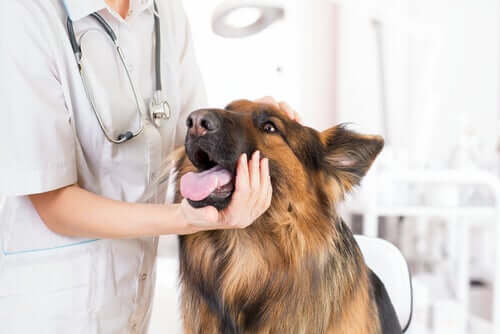Elbow Dysplasia in Dogs: Causes and Treatment

Is your dog showing discomfort or pain in any of their forelimbs? Do they refuse to move around? In that case, they may be suffering from elbow dysplasia. So, today we’ll tell you all about this ailment that appears at an early age, particularly in large male dogs.
Elbow dysplasia in dogs
This is a developmental disease. The first signs usually manifest after their 4th or 5th month of life. The main cause is that there’s no harmonious growth of the ulna and the radius. These are two of the three bones that comprise the elbow joint.
So, because the bone tissue doesn’t develop properly, then the dog might have arthritis (inflamed joints) at the beginning. However, it’ll lead to osteoarthritis, which is the progressive wear of both the bone and the joint.

This medical condition can occur both unilaterally and bilaterally. And it affects males more than females. In addition, the term elbow dysplasia encompasses four different pathologies:
- Fragmented Coronoid Process
- Ununited Anconeous Process
- Articular Incongruence
- Osteochondritis dissecans (OCD)
Continue reading to find out more about the causes, symptoms, and treatment of elbow dysplasia in dogs. This is an inherited pathology that mainly affects large males. So, consult your veterinarian at the slightest suspicion that your dog may have this condition. It’s fundamental to lessen the consequences and guarantee their quality of life.
An inherited disease that usually affects large breeds
Elbow dysplasia usually affects the largest animals and those that grow faster. However, no dog is exempt from it.
In any case, the breeds most prone to this disease are:
- Neapolitan Mastiff
- Rottweiler
- Saint Bernard
- Bernese Mountain Dog
- Labrador Retriever
- Newfoundland
- Golden Retriever
- German Shepherd
The origin of this ailment is genetic, thus passed down from generation to generation. So, it tends to show itself according to factors such as the environment, extreme cold, and humidity. Weight and diet also play an important role. Thus, you must avoid excess calcium, vitamins, and proteins in their diets. Also, reduce risks of trauma during their physical activity while they’re growing.
Learn to recognize the signs
The most common signs of elbow dysplasia in dogs are:
- Lameness when beginning to move or after exercising for a long time
- Intolerance to physical activity
- Manifestations of pain
Consult your veterinarian immediately if you notice any of these signs. An early diagnosis will reduce the consequences of this disease. This way their elbow joint will be in better shape and the discomfort won’t be as bad.
Also, if your pet doesn’t have any symptoms, but they’re prone to it due to their characteristics, consult a doctor to rule it out. If they confirm it, then have them begin treatment as soon as possible. Keep in mind that if you don’t offer timely treatment to your four-legged friend, they’ll decline progressively, together with their quality of life.

Diagnosis and treatment of elbow dysplasia in dogs
Generally, veterinarians base their diagnosis of this pathology on:
- The dog’s medical history
- Their symptoms
- A complete physical examination
- X-rays and other diagnostic imaging tests.
Thus, if the professionals confirm that your pet has this condition, then they’ll offer you various treatment alternatives such as:
- An orthopedic complement to properly fix the elbow joint
- Absolute rest
- Changes in diet
- A weight loss plan
- Analgesic and anti-inflammatory administration
- Physiotherapy
- Finally, surgery (in the most severe cases)
And, although the evolution of this disease varies according to its severity, it’s usually a good idea to do a surgical intervention before the animal develops osteoarthritis. So, consult your veterinarian as soon as possible at the slightest suspicion that your dog may have elbow dysplasia.